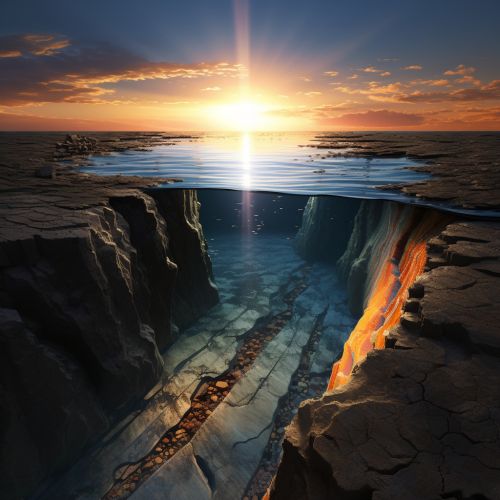Subduction
Introduction
Subduction is a geological process that takes place at convergent boundaries of tectonic plates where one plate moves under another and is forced to sink due to high gravitational potential into the mantle. Regions where this process occurs are known as subduction zones. Rates of subduction are typically measured in centimeters per year, with the average rate of convergence being approximately two to eight centimeters per year.


Process of Subduction
Subduction starts when two tectonic plates collide and the denser plate — usually an oceanic plate — is forced under the less dense plate. The process of subduction has powered some of Earth's most significant geological activity, including earthquakes, volcanic activity, and the creation of mountain ranges.
Initiation of Subduction
The initiation of subduction zones is a matter of ongoing study and debate among earth scientists. Some researchers propose that subduction zones may initiate when a dense oceanic plate bends and plunges into the mantle at a pre-existing weakness in the lithosphere. Others suggest that intense compression forces at a continental margin may cause the lithosphere to buckle and initiate subduction.
Subduction and the Mantle
As the subducting plate sinks into the mantle, it experiences increasing pressure and temperature. Hydrous minerals within the sinking plate undergo metamorphism and release water into the overlying mantle wedge. This water lowers the melting point of the mantle rock, triggering partial melting and the formation of magma. This magma often leads to volcanic activity at the surface.
Subduction and Earthquakes
Subduction zones are also the sites of intense seismic activity, including some of the world's most powerful earthquakes. As the subducting plate sinks deeper into the mantle, it encounters increasing resistance, which can cause the plate to become locked in place for extended periods. When the stress exceeds the frictional resistance, it is released in the form of an earthquake.
Effects of Subduction
Subduction is one of the key processes of plate tectonics and has led to some of the most significant geological features and events on Earth.
Creation of Mountain Ranges
Subduction zones often lead to the formation of mountain ranges. This occurs when the overriding plate is a continental plate, and the compressional forces lead to uplift and folding of the continental crust. Examples of mountain ranges formed through this process include the Andes Mountains in South America and the Cascade Range in North America.
Volcanic Activity
Subduction zones are often associated with significant volcanic activity. As the subducting plate sinks into the mantle and releases water, it leads to the formation of magma that can rise to the surface and form volcanoes. This process is responsible for the creation of volcanic arcs, such as the Pacific Ring of Fire.
Trench Formation
Subduction zones are also characterized by the formation of deep oceanic trenches. These are the deepest parts of the ocean, formed where the oceanic lithosphere bends downward and begins its descent into the mantle. The Mariana Trench in the western Pacific Ocean is the deepest point in the world's oceans, and it is an active subduction zone.
Conclusion
Subduction is a fundamental aspect of plate tectonics, driving the recycling of oceanic lithosphere into the mantle, leading to volcanic activity, and causing some of the Earth's most powerful earthquakes. Despite its global significance, many aspects of subduction, including the initiation of subduction zones and the detailed mechanisms of earthquakes and volcanism, remain areas of active research in earth science.
